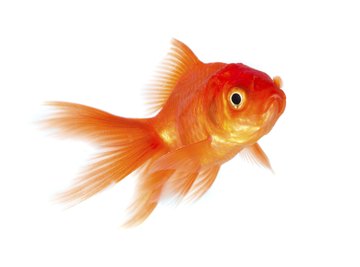
Goldfish may not be cuddly, but they can assist with your next science project. Goldfish make great subjects for study because they are a hardy species and live in an environment that can be completely controlled, which makes it easy to isolate and test one variable at a time. Take care to design an experiment that will not threaten the health of your goldfish.
Train a Fish
Are goldfish intelligent enough to be trained? Investigate this question by modeling an experiment after Ivan Pavlov's famous dog training study. Put two goldfish in separate bowls placed in separate rooms. One will be your control and one will be your experimental fish. Record the feeding behavior of both fish every day, but ring a bell for 30 seconds before every feeding for the experimental fish. During the last week of study, ring the bell for both fish without feeding them and record the differences in their behavior. If your experimental fish was trained to associate the bell with food, it will act excited when the bell rings even if food does not follow.
Test Temperature Changes
Does a change in water temperature affect the respiration rate of a goldfish? Test this idea by putting goldfish into three different tanks with temperatures of 15, 21 and 26 degrees Celsius. Give the fish 5 minutes to acclimate to their new temperatures. Then spend 1 minute counting how many times each fish's gill covers or mouth opens to determine its respiration rate, and then compare the rates for the fish in the different water temperatures. Goldfish like cold water and can survive a range of temperatures, but be careful not to change the water temperature too dramatically, as this could harm your pet.
Study Light's Effects
Does exposure to light affect a goldfish's color? Test the effects of full-spectrum light on goldfish pigment by moving a goldfish to a dark environment and keeping it there. Take a picture of the fish every day, and record observations about its coloration. Review your observations to determine whether change has occurred over the time the goldfish was kept in the dark. The fish's color will likely have faded in the absence of light. The color of a goldfish's scales is also influenced by the food it eats, which is a factor that should be kept consistent throughout the experiment and mentioned in the discussion of your results.
Symbiosis Study
Do goldfish help aquatic plants grow? Answer this question by using four fish tanks, each occupied by 0, 1, 5 or 10 goldfish. Plant an Elodea plant in each tank. Then observe and record the growth of the plants for 1 month. The nitrates and nitrites in goldfish feces should act as fertilizer for the Elodea, helping it grow faster. In return, the Elodea will release oxygen into the water that the fish require for respiration. This symbiotic relationship should be the most evident in the tank with the most fish.
References
About the Author
Sarah Cairoli began her writing career in 2002, as a reporter for the "High Country Independent Press" in Belgrade, Mont. She then spent two years writing and editing for an online publishing company, and earned her master's degree in English from Northern Arizona University. Cairoli also writes for "Bozeman Magazine."
Photo Credits
cookelma/iStock/Getty Images
